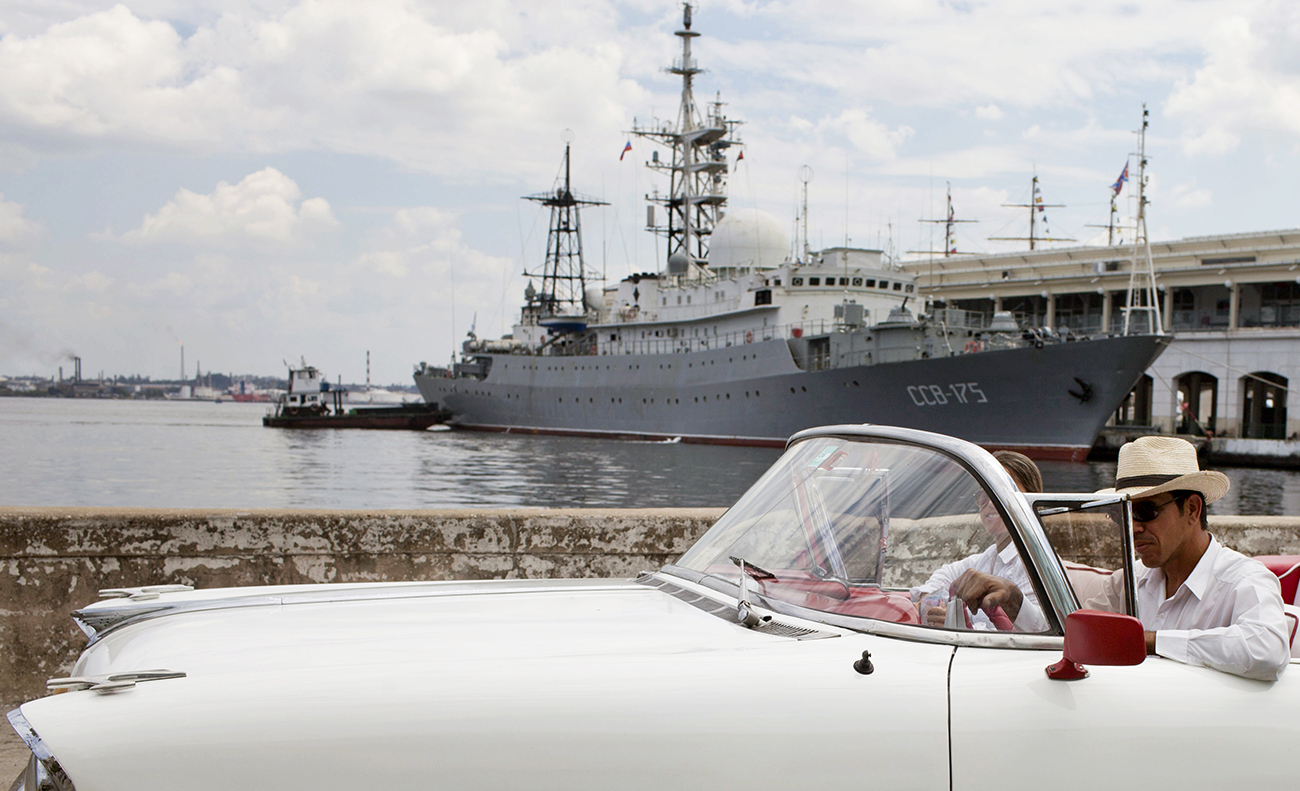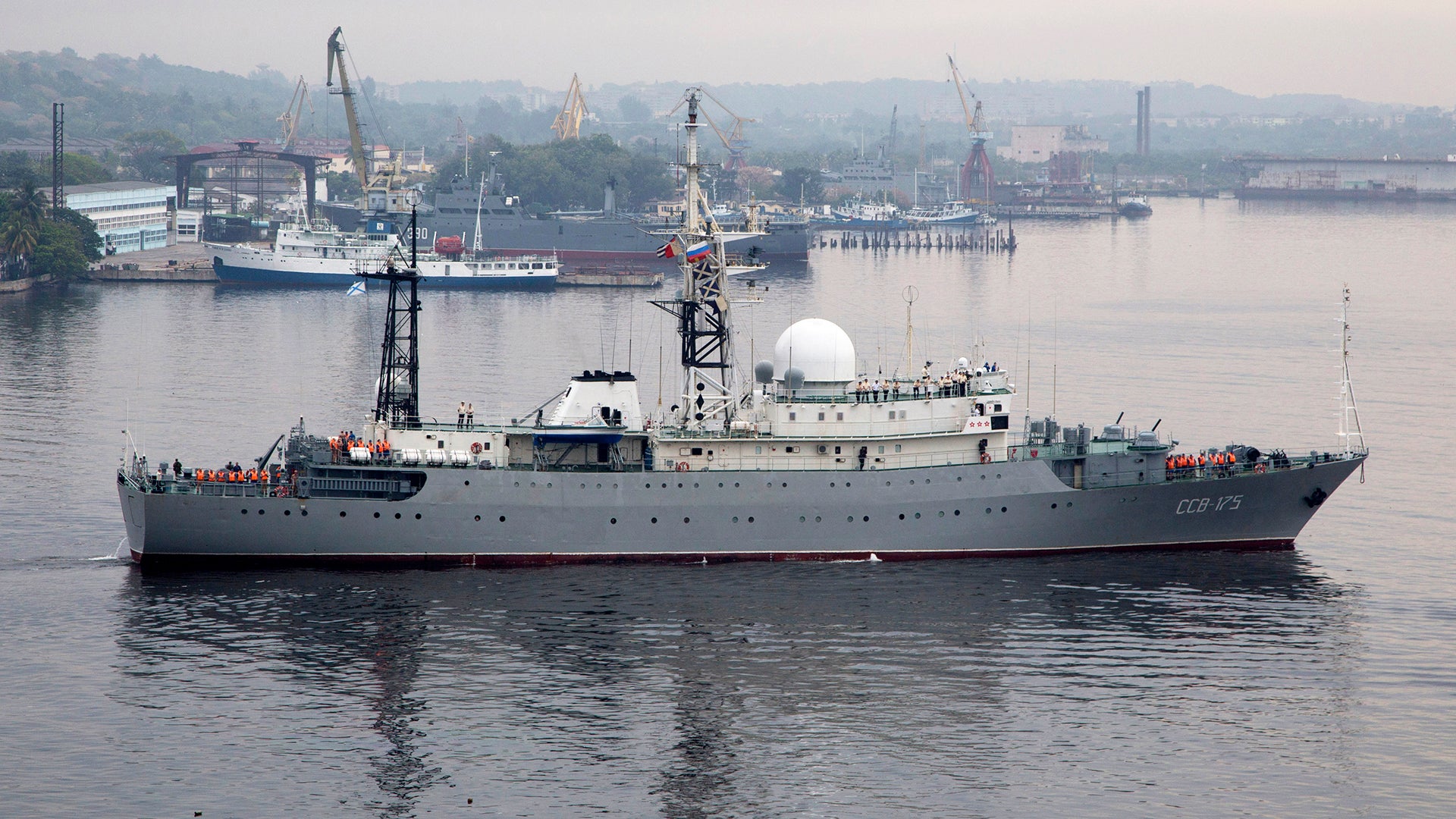The Russian Vishnya class intelligence collection ship Viktor Leonov has been prowling up the east coast, keeping about 30 miles from the shore in international waters. In recent days it has loitered off Groton, Connecticut, one of America’s master submarine bases, drawing ire in the press and interest from public.
The ship is used primarily as a signals intelligence collection platform, sucking up electronic emissions such as communications and datalink transmissions. It is also likely equipped with hydrophones to listen for underwater contacts and to record their acoustic signatures. The ship is minimally armed for self defense with AK630 close in weapon systems and SA-8 short-range surface-to-air missiles, so it poses no kinetic threat to anyone ashore or even to nearby shipping traffic. Regardless, it is being closely shadowed by the US Coast Guard.
Russian intelligence ships have a history of cruising the eastern seaboard, but generally they don’t roam as far north as Connecticut. The deepening tension between the US and Russia, as well as major accusations over the Trump Administration being infiltrated by Russian interests, have elevated the ship’s presence in the media to laughable proportions.
Russian intelligence ships, like the Viktor Leonov, often spend time in Cuba before or after operations off American shores. In 2014 the ship sortied from Cuba to Naval Station Kings Bay, the east coast home of America’s nuclear ballistic missile submarines (photo AP):

A press conference originally set up to announce the President’s pick for a replacement candidate for Labor Secretary, quickly turned into a venomous exchange with the media, which the administration has dubbed “the opposition party.” Russia was the main topic, and questions over the ousting of his short-lived National Security Advisor Michael Flynn took precedence. Trump denied any connections between him, or anyone on his campaign, and Russia. He also reasserted his message that the real story is unchecked leaks from the intelligence community—and most likely his own staff—not the actual possibility of having a Russian mole in the White House.
During the fiery back and forth with reporters, which at times spun out into useless tangents and bizarre thought fragments, Trump brought up the presence of the Viktor Leonov. The comment was in relation to satisfying what he thinks is the media and the public’s overwhelming ire for Russia, stating, “The greatest thing I could do is shoot that ship 30 miles offshore out of the water. Everyone in this country is going to say “Oh, that’s so great…’ That’s not great. That’s not great. I would love to be able to get along with Russia.”
Another reporter listed recent military actions by Russia, including flying jets flying low near a US destroyer in the Black Sea, deploying ground-launched cruise missiles against a major weapons treaty, as well as the Viktor Leonov’s presence off the east coast. Trump replied in real time to each event repeating “not good” for every instance. He also said that the Russians are probably doing these things now because they think there is little chance of being able to get along with US under the current political conditions brought on by the accusations.

Russia’s spy ship came up yet again during the press conference. Trump reiterated that he won’t discuss his military plans, and cited President Obama’s highly disclosed military timetables. Trump listed multiple examples of issues he was not willing to talk to the media about, stating, “What am I going to do with the Russian ship? Hopefully nothing. But I’m not going to tell you.” He went on to say the same thing for his plans for North Korea as well as other strategic issues.
Overall, Trump made it clear that he would like to get along with Russia, and that taking a hard stance on Russian related issues now would keep him from doing “a deal” with Moscow in the future.
As for the Viktor Leonov, it is hardly a pressing issue. Although sitting a couple dozen miles off the home of many of America’s nuclear fast attack submarines sends a message that “we’re here whether you like it or not,” the fact is Russia is not alone when it comes to standoff intelligence collection—far from it.
America and its allies use ships and submarines to execute this same mission-set all the time, and Russia is often the target. Custom built-intelligence collection ships are forward based for the sole purpose of monitoring Russia’s naval operations near their own home port. The US in particular has a diverse armada of aerial intelligence gathering aircraft designed to fly along foreign borders to soak up electronic intelligence and to take pictures and synthetic aperture radar images of key installations—and it does it all the time. These include RC-135s, U-2s, RQ-4s, P-8s, EP-3s among others.

Basically, the Russians are doing on a small scale what the US and its allies do on a daily basis around the world: that is spying in international airspace and waters. Certainly, having a Russian spy ship off the northeastern shores of the US may be interesting and something to keep an eye on, but it’s not as if the Russians sailed the Northern Fleet across the Atlantic to take up station off Washington, D.C. The ship’s actual intelligence gathering capabilities are also questionable. Sensitive information is highly encrypted and travels on discreet networks that are designed to take this form of spying into account.
It doesn’t really help national security to act as if the presence of a signals intelligence collection ship going about its business is an overtly threatening act. America and its allies do similar things every day. In fact, portraying the ship’s presence in such a manner can put our own pilots and mariners—and those of our allies—in greater danger than they already are.
Contact the author: Tyler@thedrive.com
